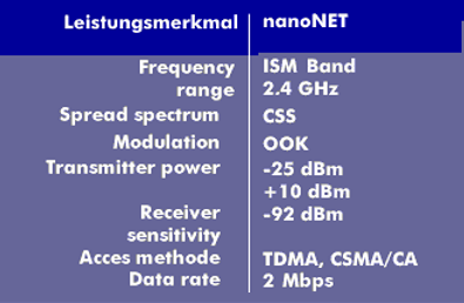nanoNET
NanoNET is a WLAN developed by the company Nanotron, Berlin. Like ZigBee and Bluetooth, with which it can be compared, NanoNet operates in the ISM band at 2.4 GHz. In contrast to the aforementioned WPAN technologies, the NanoNet uses a special transmission method with Multi Dimensional Multiple Access( MDMA) and the resulting Chirp Spread Spectrum( CSS).
As far as the chirp spread technique is concerned, this transmission technique uses chirp pulses. In these pulses, the chirp frequencies change continuously within the time duration of the chirp pulse, just like a sweep. The data rate of the nanoNET corresponds with max. 2 Mbit/s to that of Bluetooth. However, in addition to TDMA, which also uses Bluetooth, and CSMA/ CA, which uses ZigBee, nanoNET offers Aloha as another access method.
nanoNET works connectionless and can be used for point-to-point as well as point-to-multipoint connections. The addressing range covers `2^48` addresses. Transmission security is ensured by authentication and encryption. For authentication, nanoNET uses the challenge- response method, for data transmission a key length of 128 bit. In addition, nanoNET offers cyclic block checking(CRC 16 or CRC 32).

